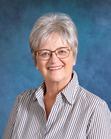Elizabeth J. Duncan's Blog: Elizabeth J. Duncan's Blog, page 3
April 22, 2012
Talking to … Vicki Delany
We’re talking to Vicki Delany, one of Canada’s most varied and prolific crime writers, whose newest book, Gold Mountain, is published today.
Where do you live and why do you choose to live there?
I live in Prince Edward County, Ontario. I moved here four years ago because I wanted to get out of the busy and crowded Greater Toronto Area and have a place in the country.
Was there a moment that changed everything when you knew you were a writer?
Nope. More a gradual thing, I’d say.
What is your most memorable experience in a library or bookstore?
My very first book signing was at a store in London alongside my good friend the writer and musician Rick Blechta. Scare the Light Away is a standalone suspense novel in which a woman reads her mother’s lost diary of being a war bride, and thus uncovers the secret of her past. An elderly lady came up to our table and I began my sales pitch. Her face began to crumble. Tears began to flow. “I don’t… think I’d… care for that,” she sobbed. “My husband died a year ago. I’m reading his journals. I thought I knew him…. But I didn’t.” Whereupon she burst into tears and fled.
Not funny at the time, I can tell you. It’s a wonder I ever did another book signing.
About your writing life
Describe a typical day in your life when you are working on a book, that is writing, re-writing, editing, proofing.
If I’m home, I’m working on a book. Every day.
An average day for me is pretty easy to describe. I write every morning for three to four hours, seven days a week, that includes anything related to producing a book such as editing or proofing. In the afternoon, I do whatever non-book writing is required, such as this interview. I’m lucky enough to have been able to take early retirement from my job as a systems analyst in a major bank and now writing is my full-time job. But it wasn’t always like this. My first book took over four years to write on Sunday afternoons between the job and three children.
I write in several very different styles and I find that I have to stick strictly to whatever style of book I’m doing until it’s finished. No jumping between books or I’d get confused if it’s supposed to be funny or heart-breaking!
I’ll also mention that I read. A lot. I don’t have a TV and I rarely go to movies.
Describe your writing process. How do you get from concept to finished manuscript?
I pretty much write from page one to page XX, and then go back and fill in anything that’s missing or needs clarification, tidy up the dialogue add more description or emotion, then another pass to make sure it all ties together and the writing is crisp. After that I’ll put it in a drawer for four to six weeks, and work on it again. I find that the break allows me to approach it with a fresh eye.
In most cases I have a rough outline, some idea of what I want to say, what I want to happen in the characters’ lives or what the crime is about. I wrote Winter of Secrets by having a scene for chapter one in mind and just starting. I figured out what was going on only as I wrote it. But I do find it much easier to have some direction.
Do you listen to music while you work? If so, what type/artist/songs?
No music. No radio. Otherwise I couldn’t concentrate.
Share a memorable experience you had with a reader.
I was in Hawaii, at a resort, walking by the pool and there was a woman stretched out on a lounge chair reading In the Shadow of the Glacier. That felt pretty special.
What’s the nicest thing a critic or reader has said about your work?
Publisher’s Weekly gave Winter of Secrets a starred review saying it was “artistry as sturdy and restrained as a Shaker chair.” I loved the idea that what I do, what we do, is art.
Which mystery author, living or dead, has influenced your writing the most?
A difficult question to answer in that there are so many. I read a lot; I’m from a reading family. Over the years I’ve read countless authors, and I’m sure all of them have had some impact on me. However, if I was to pick someone, I’d say that I love the traditional British police procedurals the most. Susan Hill, Deborah Crombie, Peter Robinson are powerful influences on my writing today. I read mysteries (or crime novels as I prefer to say) most of all. The variety is so great, that’s one of the best things about crime writing.
It was probably Sara Paretsky when she began the V.I. Warshaski series, who introduced me to reading mystery novels. Until then I thought crime writing was about a bunch of tough, misogynist guys and it had no appeal to me. I’ve never been one for the classics of crime. People are always talking about Agatha Christie or Rex Stout or John D. MacDonald, I can’t say those people influenced me at all.
Do you think writers are born or made?
Writers are born; authors are made. You have to have some degree of talent to be able to write a good story and do it well. I am totally tone deaf; I’m well aware that I have no musical talent whatsoever, which is probably why I’ve never tried to be a singer. Having said that, to write a book and then have it published, with all the work and rework and rejection and dedication that involves, you have to be pretty determined to do it.
What is the most rewarding part of being an author?
The best part of being a mystery author in Canada is the people I’ve met and the friends I’ve made. I never started out thinking I wanted to be a writer so I could make new friends, but that turned out to be the best part of all. The Canadian mystery community is by and large very close and very supportive. It’s just great.
What advice would you give to aspiring authors?
In all of your life you will have ONE first book. Make it count.
About your new book
Gold Mountain is the third in the Klondike Gold Rush series from Dundurn (following Gold Digger and Gold Fever). The books are set in Dawson City in 1898 at the height of the Klondike Gold Rush. They’re intended to be on the lighter side, a bit of a mad cap romp through the muddy streets of Dawson.

This book goes back to the summer of 1897 when Fiona MacGillivray fled Toronto with only a valise full of stolen jewellery and her 11 year old son, Angus. They arrived in Vancouver in time to hear the news – Gold Discovered in the Klondike! Fiona immediately set off for Skagway, Alaska, intending to open a theatre. After one encounter with the infamous gangster Soapy Smith and his henchman Paul Sheridan, Fiona wisely decides to pursue her ambitions on the other side of the border, and she and Angus climb the Chilkoot trail for Dawson City, Yukon.
A year later Sheridan arrives in Dawson with a map showing the way to Gold Mountain, a valley as warm as California. Sheridan wants Fiona come with him. Fiona wants no part of his mad plans. But she may not have a choice.
Make your pitch! Describe what happens in your latest book in two sentences.
Gold Mountain, where the hills of solid gold keep the Yukon valley as warm as California. Fiona MacGillivray has no interest in Paul Sheridan’s mad scheme to find the valley, but when the one-time henchman of Soapy Smith and her erstwhile suitor arrives in Dawson, she might not have a choice.
What challenges did you face writing this book?
I almost gave this book up not long after beginning it. In Gold Mountain, Fiona et al head off into the wilderness north of Dawson City. I’ve been to Dawson, but not north of there and certainly not on foot. I was struggling with trying to write a book set in a place I’d never been, particularly as the wilderness is a very specific setting and really can’t be captured by generic descriptions of trees etc.
Then it occurred to me – they’re after a valley as warm as California. How realistic does it have to be? From then on, I was okay.
What sets this book apart from your previous work?
Regarding the Klondike books, this book fits the tone and the style, but it is not a mystery and there is no murder. It’s a crime novel, not a ‘murder mystery’. It’s more of an adventure caper.
I also write the Constable Molly Smith series, small town police procedurals that are contemporary and deal with serious issues, and novels of standalone suspense that are sort of modern gothic. The Klondike books are much, much lighter.
The or questions
Cup of coffee or glass of wine? Wine
Twitter or Facebook? Facebook
Library or bookstore? Bookstore
Print or ebook? E-book
Setting or character? Setting
Book or movie? Book
What’s next?
My next book will be out in September from Poisoned Pen Press. It’s a modern Gothic set in Prince Edward County where I live titled More than Sorrow. I’m writing the sixth Smith and Winters book right now, tentatively called Tracks in the Snow. The fourth Gold Rush book, called Gold Web, is finished and will be out in 2013.
If you could choose anywhere in the world to write your next book, where would it be and why?
I’m pretty lucky in that I think I’ll chose right here. Where I am. I spent three weeks in Juba, South Sudan in November and got lots of writing done – there was nothing else to do. In January I was in Turks and Caicos where I did no writing although I intended to. Something about sitting in the room vs. being at the beach.
What can you tell us about your next book?
More than Sorrow will be out in September from Poisoned Pen Press. It’s a standalone suspense novel, a modern Gothic. It’s set in Prince Edward County, Ontario and has a backstory of the Loyalist settlers. Here’s the blurb:
A Loyalist refugee, a disfigured Afghan woman. They lived two hundred years apart, but they have one thing in common: Hannah Manning, once an internationally-renowned journalist and war correspondent, victim of an IED explosion. In this modern Gothic novel of heart-wrenching suspense, past and present merge into a terrifying threat to the only thing Hannah still holds dear – her ten-year-old niece, Lily.
About Vicki Delany
Her popular Constable Molly Smith series (including In the Shadow of the Glacier and Among the Departed) from Poisoned Pen Press have been optioned for TV by Brightlight Pictures. She writes standalone novels of modern gothic suspense such as Burden of Memory and More than Sorrow (September 2012), as well as a light-hearted historical series, (Gold Digger, Gold Mountain), set in the raucous heyday of the Klondike Gold Rush, published by Dundurn.

She is also the author of a novel for reluctant readers, A Winter Kill, part of the Rapid Reads series.
Having taken early retirement from her job as a systems analyst in the high-pressure financial world, Vicki is settling down to the rural life in bucolic, Prince Edward County, Ontario where she rarely wears a watch.
Visit Vicki at www.vickidelany.com , www.facebook.com/vicki.delany, and twitter: @vickidelany. She blogs about the writing life at One Woman Crime Wave (http://klondikeandtrafalgar.blogspot.com)








February 15, 2012
Talking to … R.J. Harlick
Once a month or so, as the authors in my circle publish new books, I'll interview them. We begin with R.J. Harlick, whose fifth novel, A Green Place for Dying, is published this week. This Canadian mystery is also a significant novel in its own right as it deals with the sensitive and important issue of missing aboriginal women. Pour yourself a cup of tea, pull up a chair and let's chat with Robin.
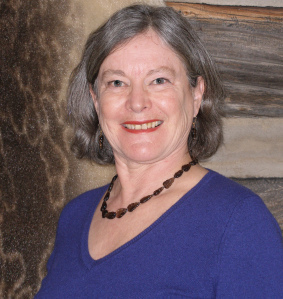
R. J. Harlick
About R.J. Harlick
Where do you live and why do you choose to live there?
First of all, thank you, Elizabeth, for inviting me to do an interview. I always enjoy reaching out to new readers.
I am most fortunate to live in two places. Although I grew up in Toronto, I was very grateful to my husband for finding work in Ottawa, a much smaller and easier city to live in. And with its close proximity to cottage country we ended up building a log cabin in the wilds of West Quebec, less than an hour's drive from our Ottawa home. Now I bide my time between the two homes and enjoy them equally.
Was there a moment that changed everything when you knew you were a writer?
Even after five books, I hesitate to call myself a writer because I still can't believe that I am actually doing it. But there was a defining moment when I decided to write a novel. I had just passed a significant birthday and was asking myself what I wanted to do for the rest of my life. Writing fiction had lurked in the back of my mind since I was a child, but I'd never actually acted on it. Looking for a change in my life, I decided the time was right and set out to write my first mystery which became Death's Golden Whisper, the first book in the Meg Harris series.
What is your most memorable experience in a library or bookstore?
I was on tour for my second book, Red Ice for a Shroud, and doing a book signing in the St. Catharines' Chapters, when a woman rushed in waving a review of my book in the Globe and Mail that unbeknownst to me had been published that morning. She couldn't wait to buy a copy and was overjoyed that I was actually in the store, so I could sign her copy.
About your writing life
Describe a typical day in your life when you are working on a book, that is writing, re-writing, editing, proofing.
I treat writing as a job, so after breakfast and walking the boys, my two standard poodles, I retreat to my office where I do whatever needs to be done with my writing. This can cover anything from the various stages of the writing process, to organizing events and doing the various online promotional activities I involve myself in, such as Facebook and blogs. When I am starting out with a new book and writing the story for the first time, after two or three hours I run out of steam whereas I can go for many hours when I am in the editing and proofing stages.
Describe your writing process. How do you get from concept to finished manuscript?
I'm afraid I am one of those writers who fly by the seat of their pants. Although I have tried to outline, invariably my characters and the story take off in directions that I hadn't planned. Now I start with an underlying theme, such as missing aboriginal women, which is the theme of my latest book, a location, which in my latest is Vancouver and Haida Gwaii, a few key characters and a starting scene. I generally have an idea of where I am going and how I want it to end, but rarely do I know whodunit until I am almost there. I am also a writer who doesn't read the previously written chapters until I reach the very end of the first draft. But I prepare a point form outline of what occurred in each chapter as I go along. This way I can keep track of the action and make notes of where I will need to make changes during the re-write.
Do you listen to music while you work? If so, what type/artist/songs?
No, as much as I love music, I would find it too distracting.
Please share a memorable experience you had with a reader.
I'm always thrilled whenever an e-mail arrives from a fan wishing to tell me how much they enjoyed my books. But I suppose the fan letter that stands out most is an actual letter that a fan took the time to pen and send via real mail. She wanted to tell me how much the reading of my books had brought back her own memories of treasured vacations spent in a cottage wilderness very much like Meg's Three Deer Point. She even included some photos of the lake.
What's the nicest thing a critic or reader has said about your work?
A difficult choice, since I have received many good reviews for my books, but I suppose the words that tend to stand out for me were those mentioned by Mike Gillespie in the Ottawa Citizen when he called me "one of the brightest new voices in the mystery business" And needless to say I am thrilled with the first review of my latest book, which came from Publishers Weekly, "Meg Harris….gets an education in evil in Harlick's absorbing fifth mystery."
Which mystery author, living or dead, has influenced your writing the most?
I'm not sure that anyone writer has actually influenced my writing, although I do strive to try to write as well as some of my favourite mystery authors, such as P.D. James, Elizabeth George, Peter Robinson, Ian Rankin, Michael Connelly and the like.
Do you think writers are born or made?
I think it takes a bit of both. I don't think you can be a writer without some natural talent, however unless you work really hard to exercise that talent, you will never become a writer.
What is the most rewarding part of being an author?
Both creating the story and completing it. I get tremendous satisfaction from creating my own story world and penning the final words gives me a terrific sense of achievement.
What advice would you give to aspiring authors?
Don't give up. At times finishing the novel and then getting it published will feel like an insurmountable goal, but keep at it for eventually you will achieve both. But don't forget the necessary re-writing to help make that happen. With each re-write your writing not only improves, but you also get to know both your characters and story much better.
About your new book
Make your pitch! Describe what happens in your latest book in two sentences.
In A Green Place for Dying, Meg Harris returns home from the Arctic to discover that the daughter of a friend of hers has been missing for over two months. Vowing to help, Meg finds herself uncovering an underside of life she would rather not know exists.
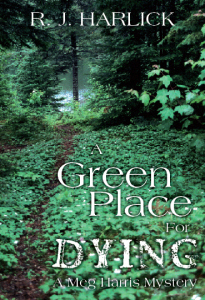
A Green Place for Dying is published Feb. 17
What challenges did you face writing this book?
Missing aboriginal women is a sensitive topic, and with two young women currently missing from an Algonquin reserve in West Quebec it was doubly sensitive in the writing of this book. Since my story involves a missing Algonquin woman, I didn't want it to mirror the situation with these two women.
What sets this book apart from your previous work?
As with most series, apart from the central mystery theme of each book, there is an ongoing back story related to Meg that evolves further with each book. In A Green Place for Dying, Meg's demons come back to haunt her and she is forced to own up to a secret she has been hiding since a child. This was alluded to in previous books and was at the core of her breakup with Eric, her friend, her lover. Now if she wants to win back Eric, she must reveal the ugly truth.
The "or" questions
Cup of coffee or glass of wine? Ah, a glass of wine….
Twitter or Facebook? – Facebook. I think if I tried Twitter I would never stop tweeting, after all I'm a robin…J
Library or bookstore? – Bookstore. I love to roam through the aisles, sampling this and that
Print or ebook? – a very tough question – I love the comfy, cozy feeling a book gives me and the feeling of satisfaction I get when flipping the last page on a good read. But I tell you, I sure love the convenience of ebooks…..
Setting or character? I love both and am most dissatisfied when a book doesn't provide me with both
Book or movie? I would much prefer to read a good book
What's next for R.J. Harlick?
If you could choose anywhere in the world to write your next book, where would it be and why?
The sixth Meg Harris mystery has already begun and I have situated it in a part of Canada that I had always wanted to visit, the Queen Charlotte Islands or Haida Gwaii, as the islands are called today. As a child, my father often spoke of these mystical islands on the edge of Canada. During his university days at UBC, he spent a summer working in one of the logging camps and had talked of returning to them, but never did. So last June as part of my research, my husband and I spent a fabulous week getting to know the islands and its people, the Haida. You can get a sneak preview of their magic from my photos on my blog http://rjharlick.blogspot.com/2011/06....
What can you tell us about your next book?
I'm still fleshing out the story of a Silver Totem of Shame, so it will no doubt change before it's finally frozen in published form, but basically it will have a Haida thread. Totem poles will play a key role, particularly their use in the telling of stories. I do know that it starts off with the killing of a young Haida carver in a carving shed on Granville Island in Vancouver. His vicious murder takes Meg to Haida Gwaii, where she gradually unravels a tangle of shame and clan rivalries that reach back to the 1880s. I want to bring the magic of these islands alive for my readers.
That was wonderful, Robin. Thanks so much. I can't wait to read A Green Place for Dying.
Visit R.J. Harlick at rjharlick.ca
A Green Place for Dying is published Feb. 17, 2012.








February 12, 2012
Love is Murder in Chicago
My mystery convention year is off to a great start. The first weekend in February is Love is Murder time in Chicago. I know what you're thinking — who would plan a conference in Chicago in February? Well, the good people who organize Love is Murder, apparently. Last year the conference began one day after a brutal snowstorm. This year, the weather was fine with no snow.
I fly Porter to Chicago. (Actually, I fly Porter whenever I can.) Porter flies into Midway but the conference is held at the Intercontinental Hotel near O'Hare, so I take the train into town with a stopover at my favourite American department store, Macy's. Just in time for lunch with special cake for dessert followed by a little shopping. Ralph Lauren is on sale so I stock up on Christmas gifts for next year for some lucky friends.
The conference gets off to a good start on Friday with sessions with authors and experts. I get on the expert track and really enjoy learning about money laundering from former IRS agent Lee Williams, CSI techniques with Susan Vondrak and financial infidelity with Peggy Tracy.
There's a lot of socializing in the evening and then we're off again Saturday. I was on a panel to discuss the intricacies of designing a series with authors Donald Bain, Barbara D'Amato, Julie James and William Kent Krueger. Donald is the real author of Murder, She Wrote and it just a pleasure to meet him. The panel was chaired wonderfully by Luisa Buehler.
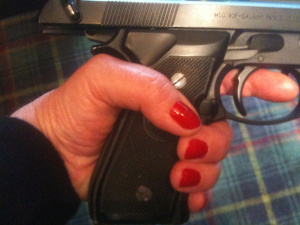
I rather liked this Beretta
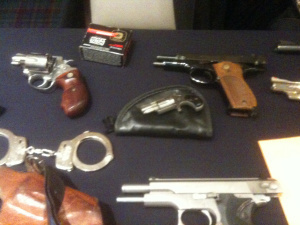
Retired police officers gave a demonstration on guns.
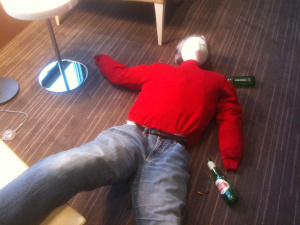
Poor Milly had a rough day and some of us knew how she felt.
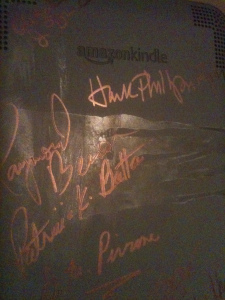
One reader asks authors to sign her Kindle.
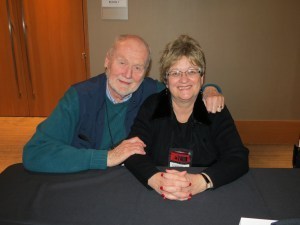
With Donald Bain, author of Murder, She Wrote
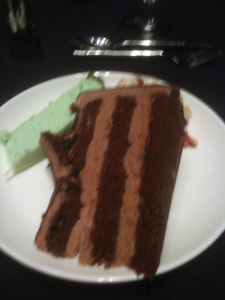
Saturday night dinner ends on a cake note
And then Sunday morning it was back to Midway and home to Dolly.








February 8, 2012
What my characters are reading
What your characters read says a lot about them. In my Penny Brannigan mystery series, Mrs. Lloyd, the former postmistress in Llanelen, fancies herself a lady, so naturally, that's her magazine of choice, although she does dip into Country Life every now and again. She takes her copy of The Lady with her to the hairdressers or to pass the time when she's taking the bus into Llandudno. And on one memorable, snowy night, she sought comfort in its pages as she waited for a suitor who never arrived.

Her favourite articles are anything about royalty — she found a recent article on what's in the Queen's handbag especially interesting — and the advertisements for domestic help. She loves the idea that the owners of great houses still seek married couples to work as cook/chauffeur. And since Florence Semple came to live with her a cross between a cook/housekeeper and a companion, Mrs. Lloyd feels she's earned her place in ladydom.
Over the years, she's noticed that the magazine has had to change to be in tune with contemporary life and to appeal to younger readers. But at the same time, it has stayed true to its core group of established readers by including articles about the traditional things they value: the British way of life, the role of women in society, conservative fashion, time saving tips, television programs like Downton Abbey and so on.
And while she loves the magazine, and in fact subscribes to it so she won't miss an issue, Mrs. Lloyd doesn't read books. Her lodger, Florence, however does read books, but she can't afford to buy them so she's a great patron of the local library.
Another patron of the local library is the rector's wife, Bronwyn. She likes Regency romances, and if the story includes an earl with a smart carriage, so much the better.
As for Penny Brannigan herself, she loves to curl up with a good mystery. Police procedures are good, but nothing too violent. At the other end of the spectrum, she's not one for cozy quilting type books set in a Maine B&B, either.
But recently, when she couldn't sleep, the librarian offered her a nice, boring history of farming practices in the former USSR.
Reading plays as much a role in my characters' lives as it does in mine.








January 28, 2012
The quiet beauty of small joys: the handwritten letter
Over the next few weeks I'm going to blog an occasional series on the small, quiet joys that enrich our daily lives. Some of these might seem quaintly old-fashioned; they used to be everyday things but now, because of their rarity, have taken on new meaning. Or they might be unexpected delights that arrive out of nowhere to lift our spirits and brighten up an ordinary afternoon.
I begin with the handwritten letter. When was the last time you received one? Or sent one?
Before the days of email, there was just mail. If you wanted to communicate with friends or family, you took the time to compose a letter, find a stamp and post it. Mothers wrote long letters to children away at university or travelling abroad. Canadian high commissions and embassies around the world accepted and distributed letters from home to backpacking twenty-somethings who rejoiced at the arrival of a light blue airmail envelope covered in mum's familiar handwriting and bearing a postage stamp with the word Canada on it.
Stationery reflected the letter writer's status, intent and sophistication. It could be as simple as a lined pad from the drug store to specially embossed, personalized paper in pale cream with matching envelopes.
And then email changed all that. Sure, email is great for immediacy, but it's not attractive and it doesn't have much staying power.
A handwritten note card or letter carries emotional weight. It takes more effort to send, so it means more to the recipient. The sender has touched it with her own hands and the writing is original and unique.
My friend Eirlys and I exchange emails but more often, we send each other letters. Newsy little note cards about what we've been up to, a little planning for our next get together in North Wales, random thoughts on this and that.
The pleasure and joy her handwritten note cards bring far outweigh what I would have experienced reading the same information on an email. Seeing one of her cards in the mail when I pick up the post, tucked in with a bill or two, brings a small surge of joy. It's great fun to reach for my letter opener (yes, I have one), slit open the envelope and pull out the card or letter. Of course, this little ritual includes a cup of tea and a sit down for a leisurely read. News of the weather and how her garden is doing. What the neighbours are up to. A suggestion for a place we might visit when we get together again in August.
And then the card goes on the mantle piece to be re-read and enjoyed again later, and then eventually tucked away in a box with other cards and letters.
Not to be deleted or forgotten.
And that's the lasting joy of handwritten notes and letters. They hold and preserve memories.








May 23, 2011
Sunday in New York
There's something special about a Sunday in New York. So much to choose from, everybody enjoying themselves. So here's how we spent our Sunday.
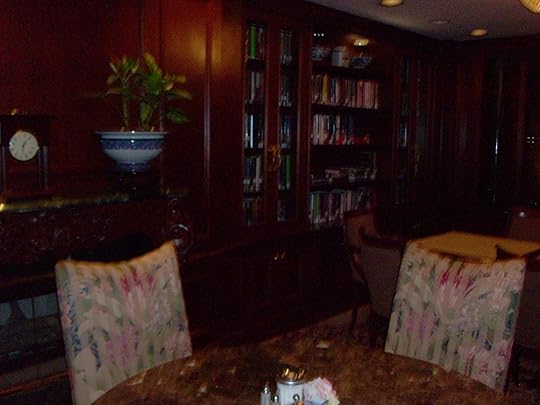
We started the day with a hearty meal in the hotel's book-lined breakfast room
And then made our way to the site of the World Trade Center. The area is fenced off and difficult to see but just being there gives you a feel for the size of 9/11. We imagine the streets filled with people trying to escape, fire fighters and police running into buildings that others are running out of, choking air filled with ash and debris…It was jarring and distressing to see smiling tourists posting for photos as if they were at Disneyland.

America rebuilds

Construction continues

The site has been under development for years
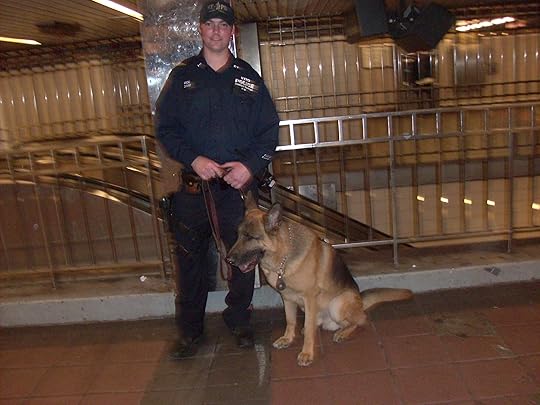
Looking professional
At 34th Street station we met this NYPD officer and his dog. When we saw them, the dog was resting comfortably. When I asked if I might their their photograph, the officer kindly agreed and then told his dog to "sit up and look professional." Which he did. Two of New York's finest!
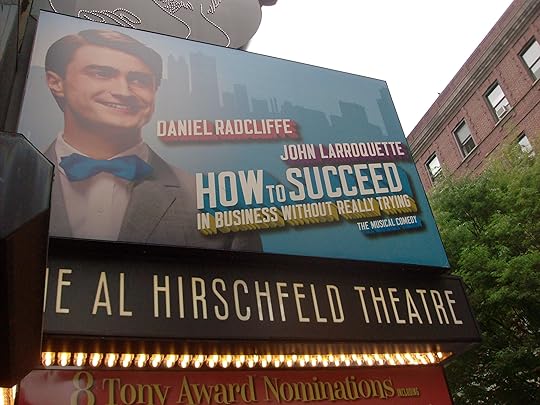
Then it was off to Broadway to see a show. Yes, that Daniel.
And then dinner at the world famous Carnegie Deli.
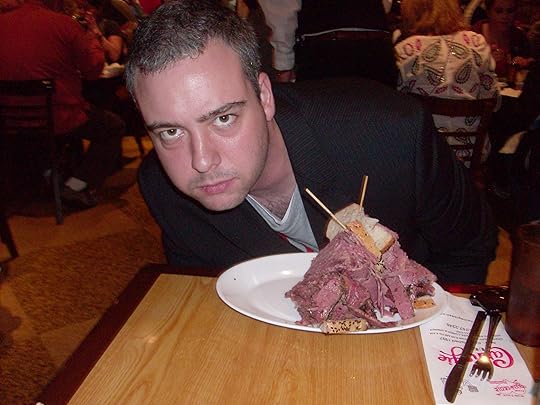
Share? I think not.
Lucas ordered a Woody Allen which was about the size of a wooly mammoth.
Here it is again, in all its meaty glory.
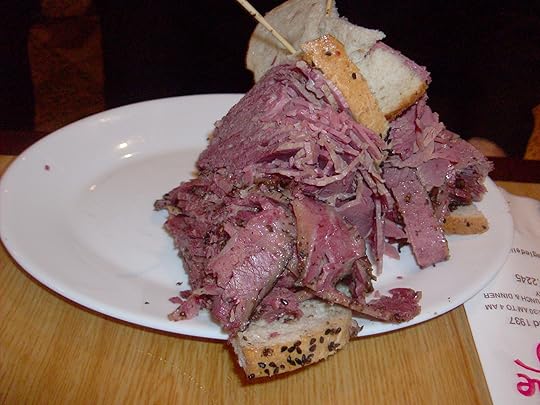
Portion control is not on the menu at the Carnegie Deli
I ordered an egg salad sandwich. I think I've gone off them for life.
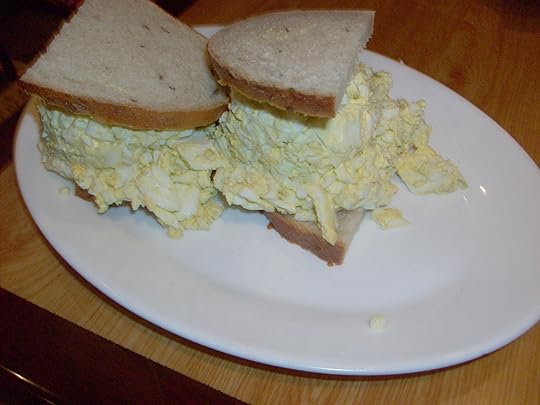
Two giant scoops of egg salad!
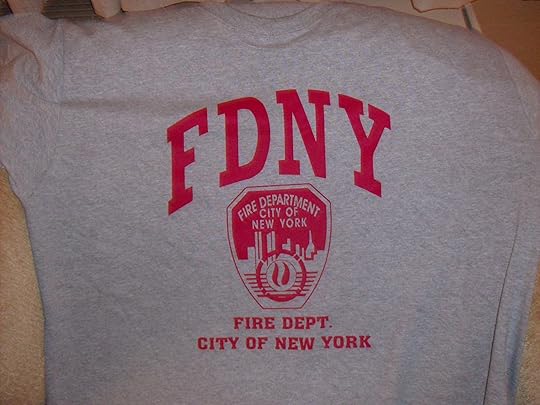
Lucas bought a T-shirt at the World Trade Center that says it all.








May 21, 2011
I still love New York
New York is a confident city. Not only is it bursting with energy but it has an undeniable sense of itself. When you're in New York, strolling down Fifth Avenue, say, there is no where else on earth you could possibly be except in the one and only New York, New York.
I have come to New York to attend the memorial service for the late Ruth Cavin. It was she who called me on the blustery March day back in 2008 to tell me that I had won the Malice Domestic/St. Martin's Press award and sadly, she died earlier this year. So Lucas and I decided to come to New York for the Victoria Day Weekend.
The trip started off Awesome! We met Neil Pasricha, author of the wildly successful The Book of Awesome at Toronto's City Centre Airport. He was on his way to Boston with dad, I was on my way to New York with my son.
We arrived at our hotel in the Upper West side and look who managed to find her way to New York with us!Cross at being left behind on the last few trips, I think Eleanor found some space in Lucas's luggage at the last minute and stowed away.
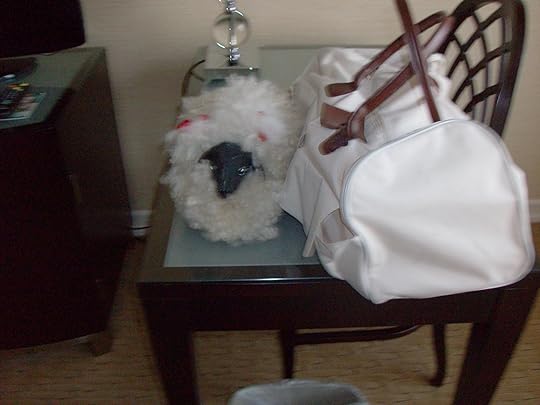
I should have known Eleanor would want to come. She loves shopping.
Leaving Eleanor happily sill sitting, I spent a few hours strolling the neighbourhood. Exploring the surrounding streets is part of the fun at staying at a new hotel.
Here are some photos from my walk.
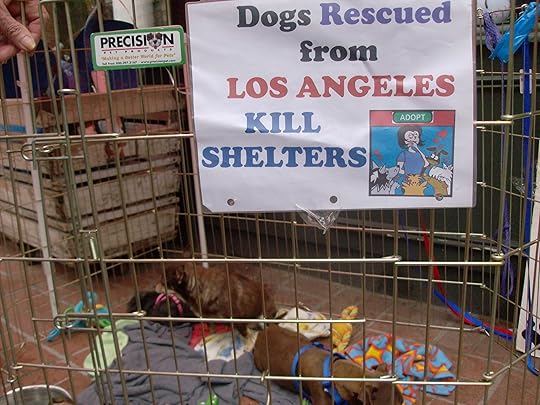
A pet store on Columbus was trying to find new homes for some dogs.

I found this little red merle mix quite adorable.
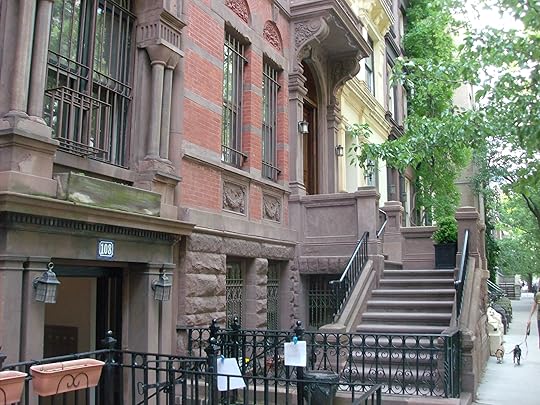
West 78th is a quintessential New York street.

The TV show Damages is going to be filming here next week.

Displays of spring flowers, including lilacs and peonies, in a sidewalk display

Here's a nice refreshment stand for a thirsty dog.
New Yorkers love their dogs. Saw lots of them being walked, sitting on benches and enjoying a romp with canine friends in the dog run outside the American Museum of Natural History.
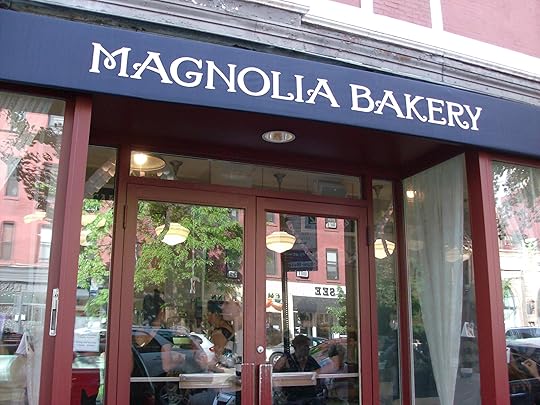
I finally reach my destination.
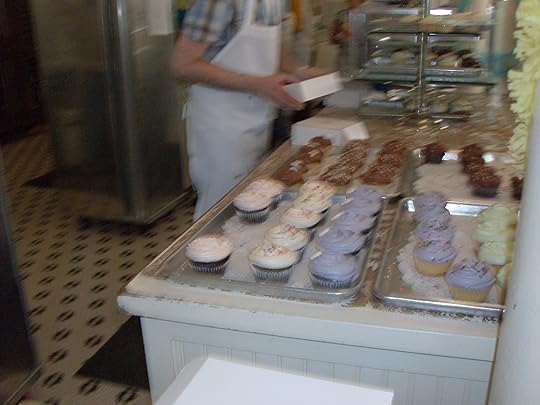
I didn't come here for mini cupcakes. I want the real thing! And six of them.
I take a different route back to the hotel and make my way down 72nd Street.
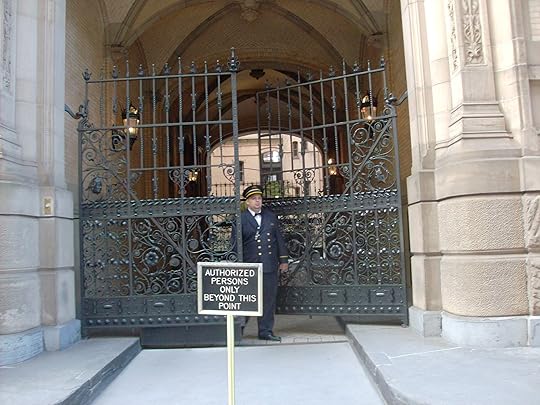
Do you know why these wrought iron gates became world famous on Dec. 8, 1980?
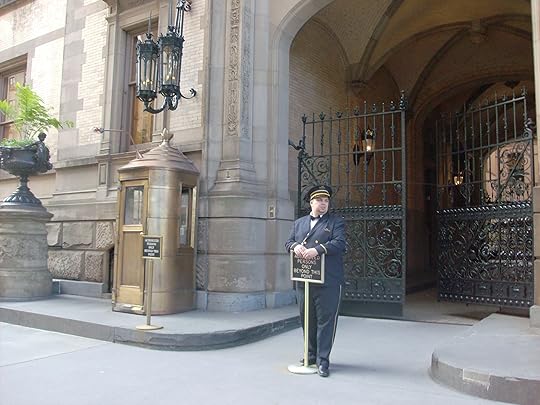
Because on this spot, about where the doorman is standing, Mark David Chapman shot John Lennon. This is the Dakota apartment building.
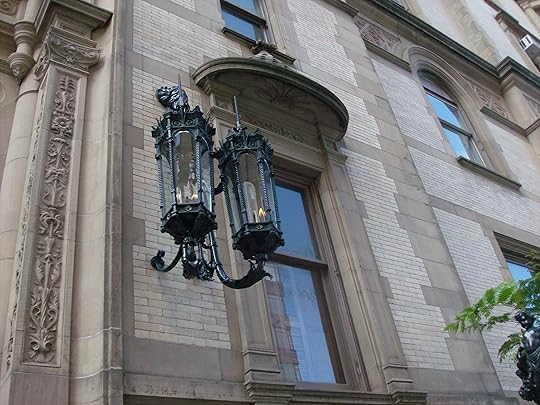
Gas flames flicker in the old fashioned lamps on either side of the entranceway. I don't know if they were burning that night.
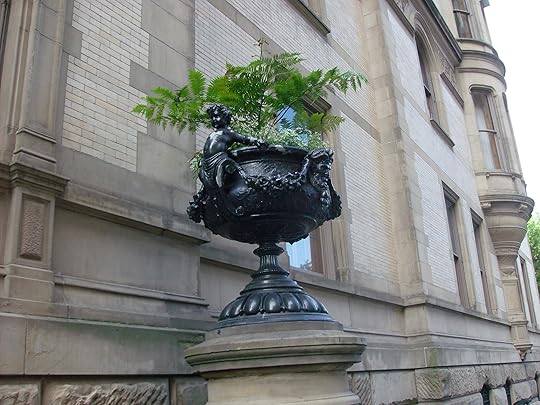
A large planter outside the Dakota
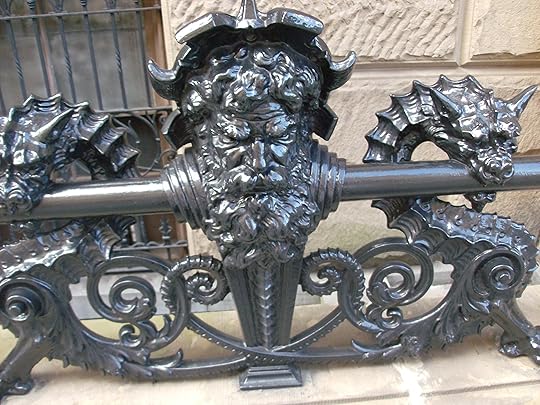
The Dakota is surrounded by a dry moat. This figure is one of many on the moat railing.
The Dakota has a long and fascinating history but it's primarily remembered for that one night. There were a few people stopping to take photos today and I'm so glad people remember him.
And then I made my way back to the hotel along Central Park West. Eleanor was very curious to see what I'd brought.
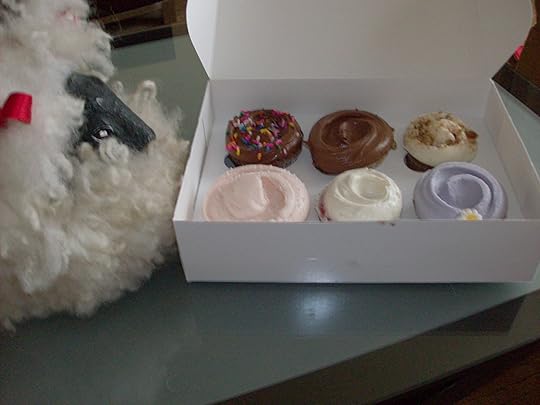
"I think good manners dictate that you take the one closest to you."
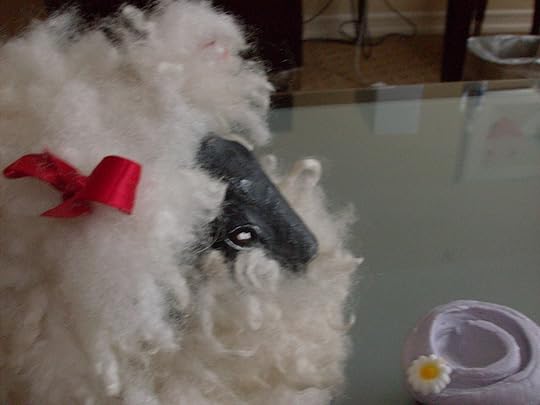
For me?








May 7, 2011
From North Carolina to Malice
We wrapped up the last couple of days of our North Carolina book tour in style.
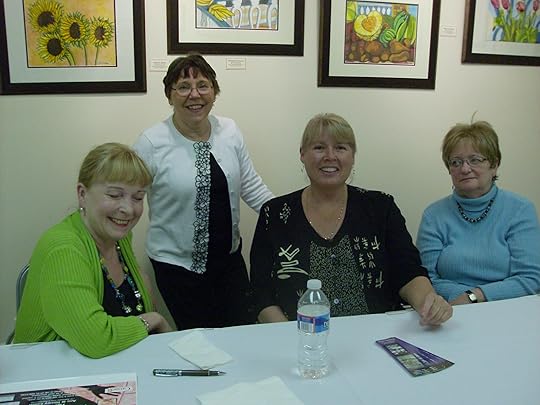
With Cary librarian Karen Kiley
This was a fun event held at the Page-Walker Hotel, also known as The Page-Walker Arts & History Center, in Cary. The building has been beautifully restored. One can look out the window on the second floor and see the railroad tracks that run by the town. Someone told me that when the civil war ended, Confederate soldiers walked home from the war along those tracks. You could picture them, their wounds wrapped in tattered, dirty bandages, stumbling along mile after painful mile.
There was a great turn out of about 50 people, and we were happy to talk to them and sign copies of our books. We appreciated that the Canadian consultate in Raleigh chipped in for refreshments. Our tax dollars at work!
The next day we had some time for shopping and visited a few book stores. The paper back version of A Brush with Death is out now and available at Barnes and Noble.
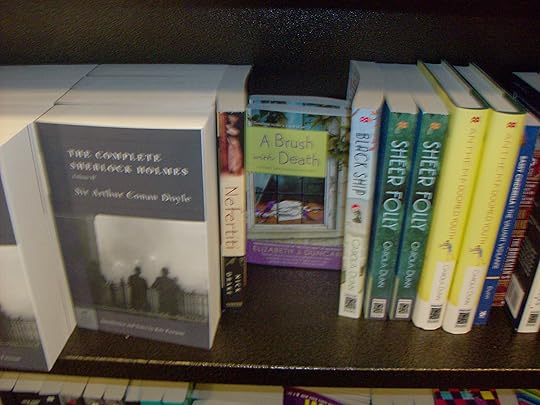
A Brush with Death at Barnes and Noble
The last event of our tour was held at my favourite venue, the Carolina Club. One of the people who attended is a Canadian and she had a flag she wanted us to sign.
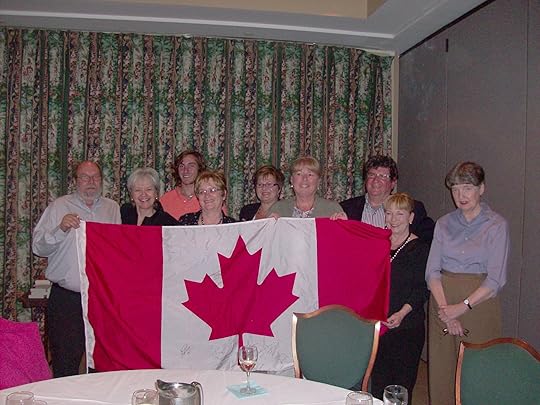
It was great to see a Canadian flag in N Carolina

Signing the flag
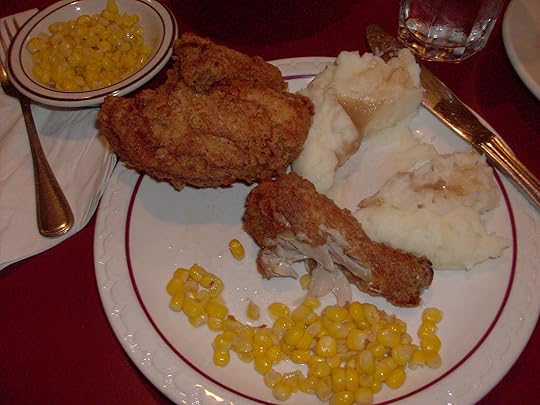
Mmm. Fried chicken
After the Carolina Club event we went for dinner at Mama Dips in Chapel Hill for traditional Southern fried chicken. The food was authentic and fantastic!
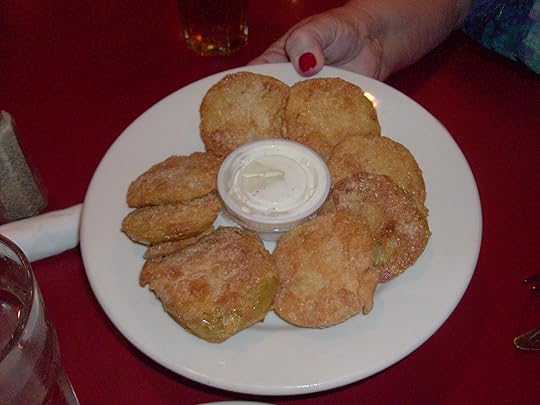
Fried green tomatoes
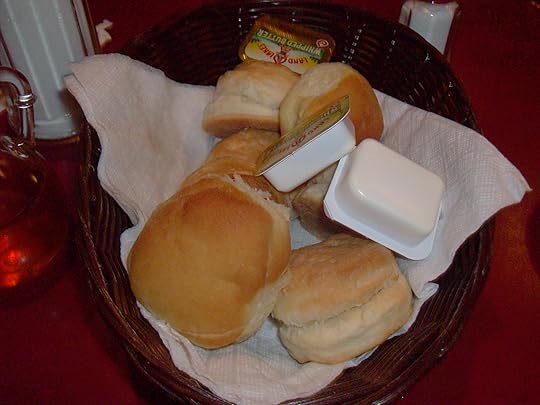
Light, delicious buttermilk biscuits
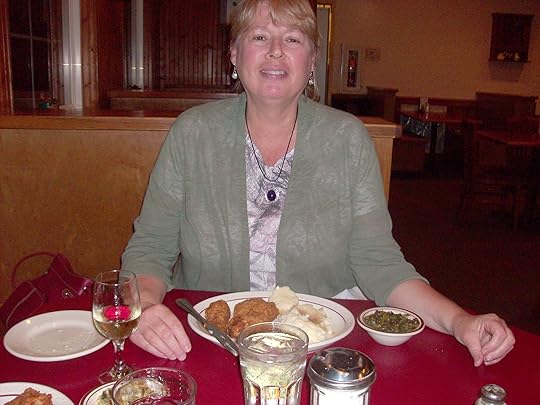
Vicki Delany gets ready to tuck in
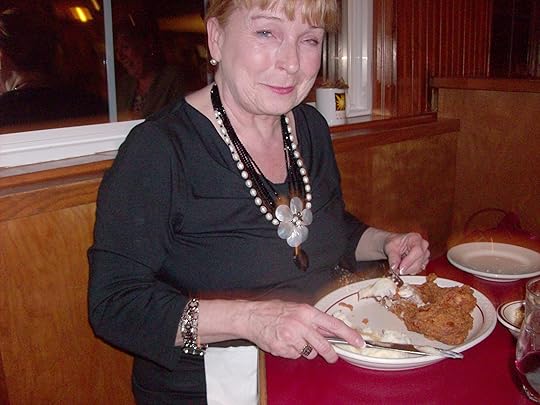
Mary Jane Maffini liked her chicken
Finally, we went back to Molly's to catch up on our e-mails and pack. We leave in the morning for Bethesda, MD for Malice Domestic. It's one of my favourite weekends of the year and my favourite conference.
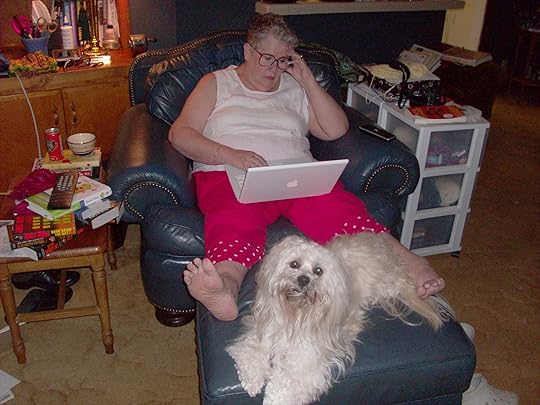
Molly Weston and Raggs
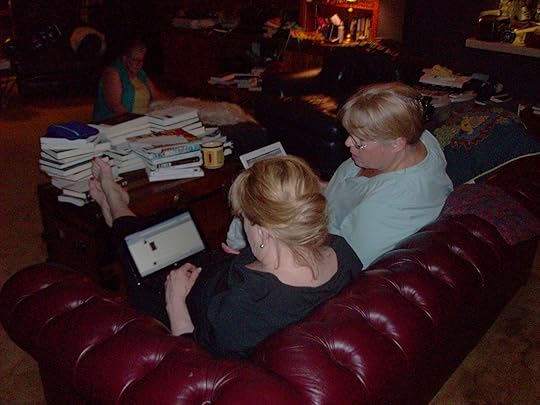
Mary Jane and Vicki finalize arrangements for Malice
With heartfelt thanks for a wonderful time in North Carolina, we set off the next morning for Bethesda, MD. Saw a couple of interesting billboards. The first one promoted a "Gun and Knife Show". The next one urged us to "Transform a life! Become an organ donor!"
So it's on to Malice.








April 24, 2011
Easter lunch in North Carolina
Canadian mystery writers Vicki Delany, Elizabeth J Duncan and Mary Jane Maffini are on a book tour of North Carolina, under the direction and guidance of media escort Molly Weston.
Here's what happened today, Easter Sunday, April 24, 2011.
A beautiful day in North Carolina. Bright blue sky, very warm. You might say hot, as temperature reached 90 degrees this afternoon.
Molly treated us to the most beautiful buffet at the Carolina Club in the George Watts Hill Alumni Center at the University of North Carolina at Chapel Hill.
It's a beautiful campus, with quite a few celebrated alumni.
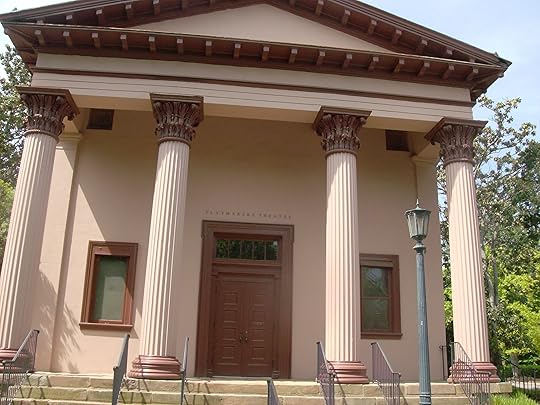
Smith Hall, the UNC theatre where Andy Griffith, of Mayberry fame, got his start.
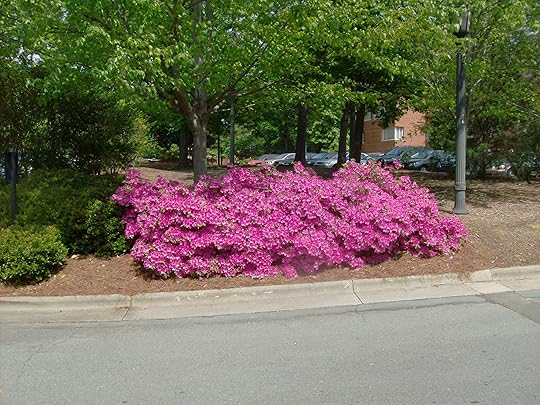
Flowers bloom on campus

Another bank of flowers outside the Alumni Center
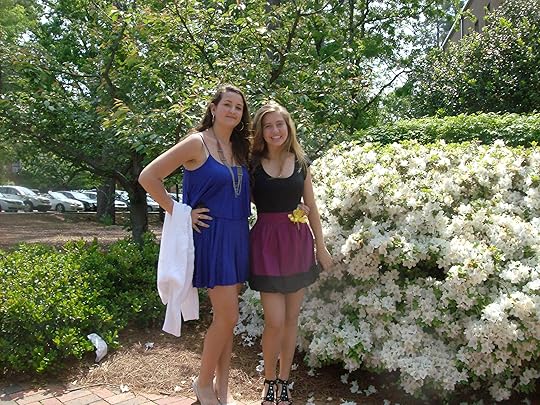
Pretty North Carolina girls in their summer dresses on their way to Easter lunch
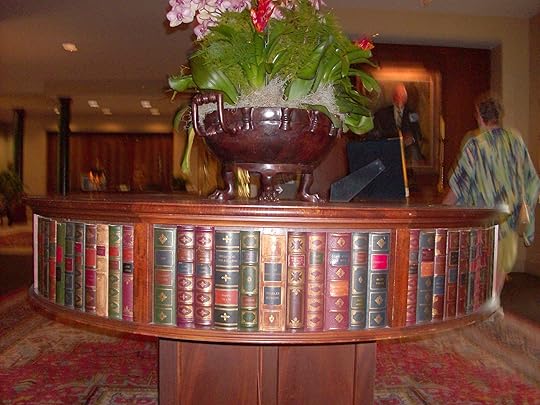
An unusual table in the lobby of the Alumni Center
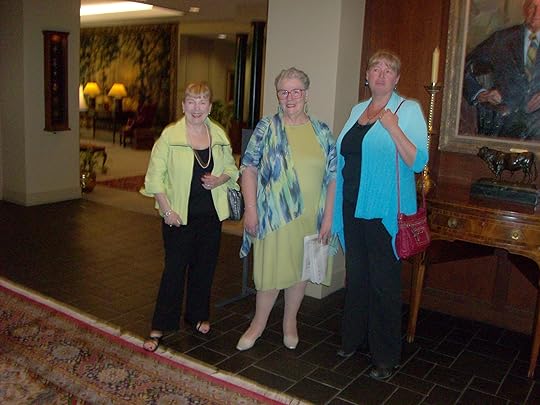
From left, Mary Jane Maffini, Molly Weston and Vicki Delany about to enter the dining room
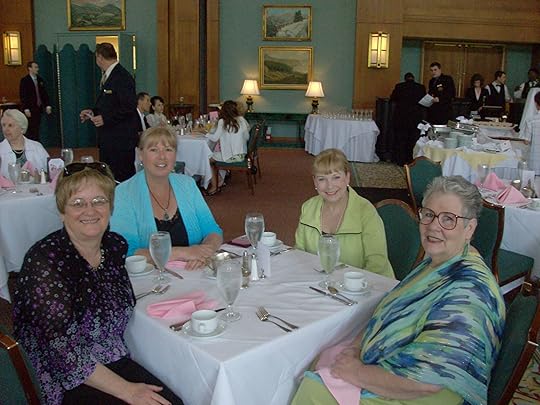
Ladies who lunch
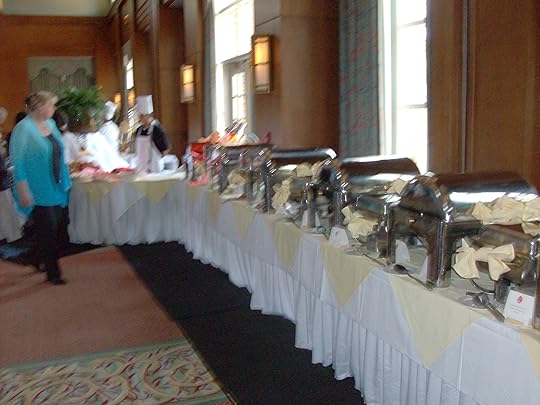
Vicki Delany tries to work out where to start
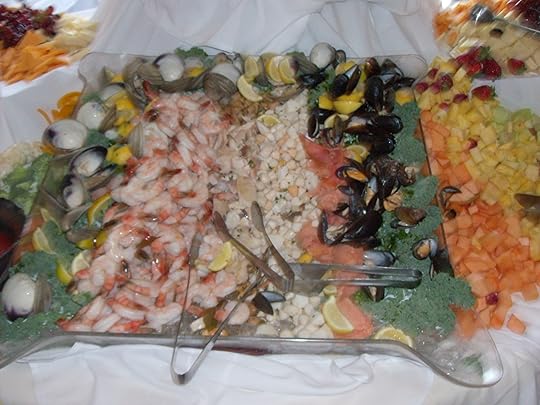
The seafood was delicious
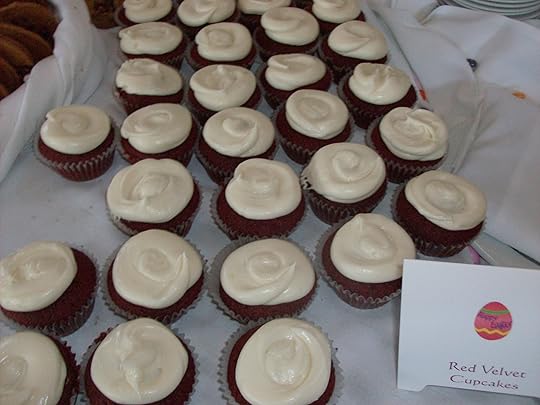
As were the desserts
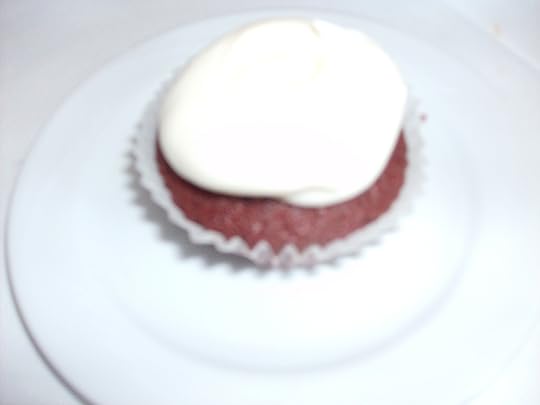
This is my red velvet cupcake
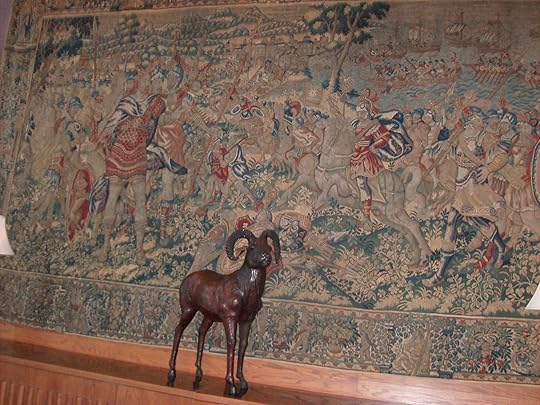
The tapestry in the dining room is late 16th century
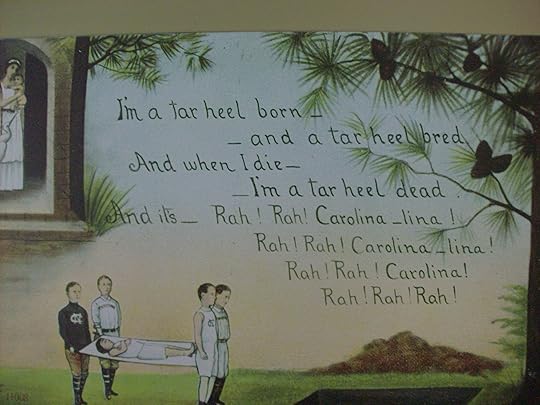
Some of the artwork is based on old postcards
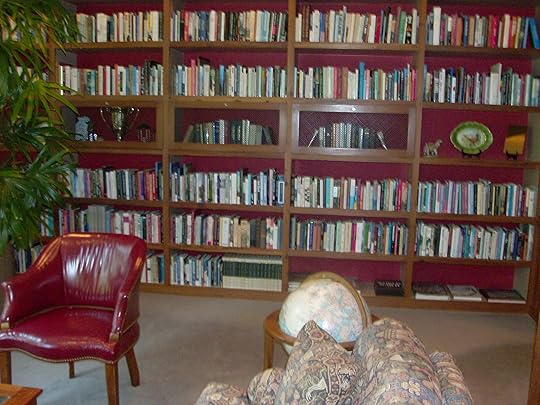
The Alumni Center features an attractive members' library
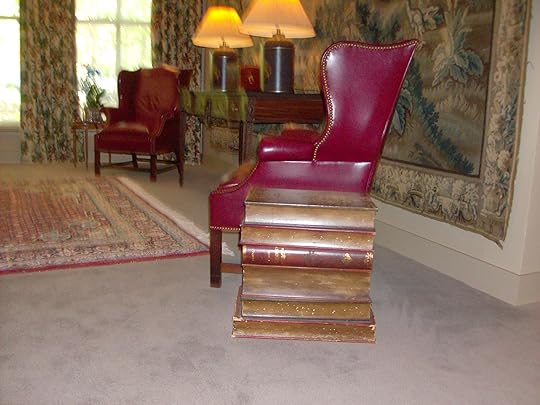
Check out the end table
After lunch, we drove out to the day lily and koi farm operated by Molly's husband.
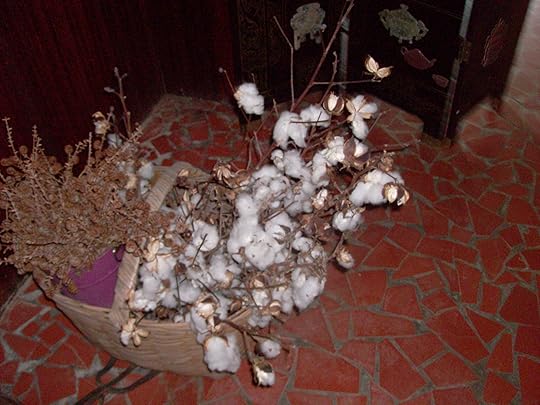
A basket of cotton. It represents so much to the south








April 23, 2011
North Carolina, Day 4
Day 4 of the North Carolina book tour was a good one. Today, we did an authors appearance at McIntyre Books in Fearrington Village. This is an interesting village, created by the Fitch family, with lovely restaurants, gardens, spa, and a well tended housing development.
The village is also home to two interesting kinds of critters: Belted Galloway cattle and Tennessee fainting goats.
Here are some photos taken at the village.

There's always someone who hasn't figured out the parking thing.
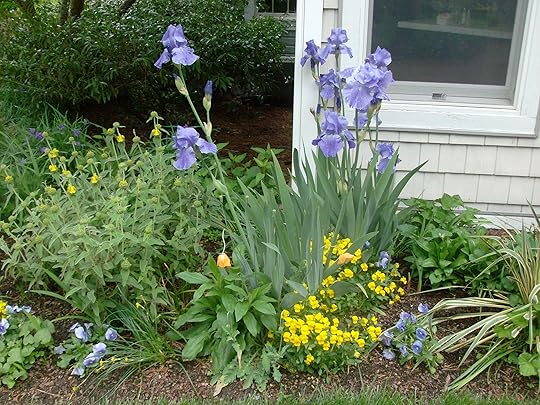
The spring gardens are in full bloom

A garden walk
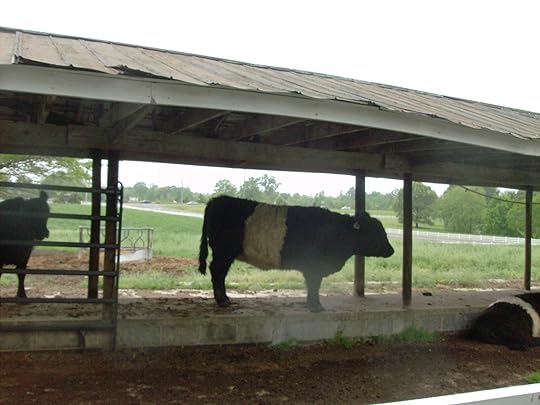
A Belted Galloway cow. The village site was originally a dairy farm.
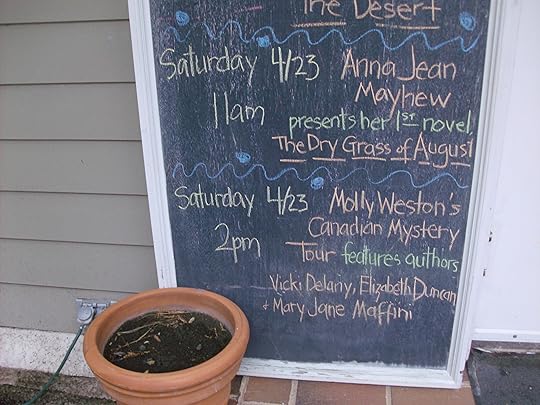
McIntyre's lists authors like a restaurant would list menu items
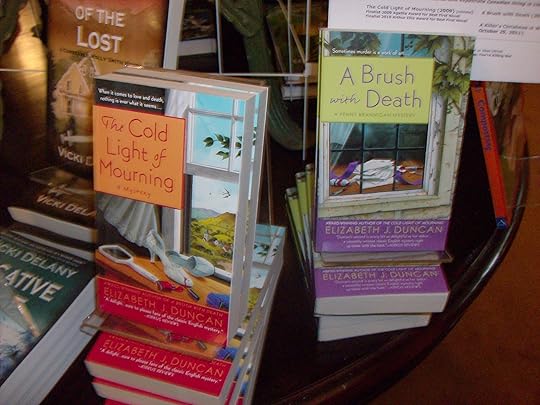
Saw the paperback of A Brush with Death for first time today
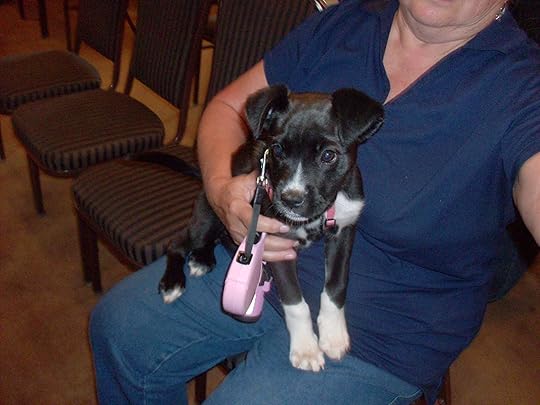
A three-month-old border collie/lab cross called Jasmine came to our presentation
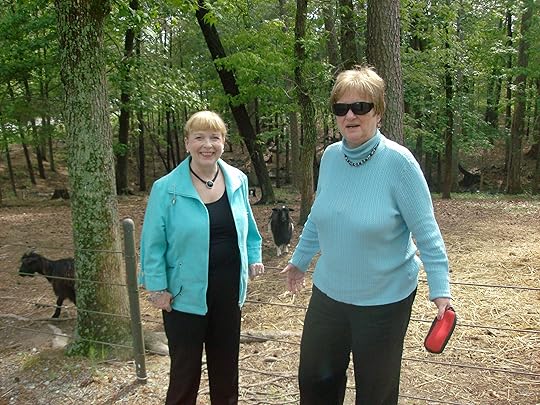
Mary Jane Maffini and I meet the goats. Our turquoise look was a clothes coincidence.
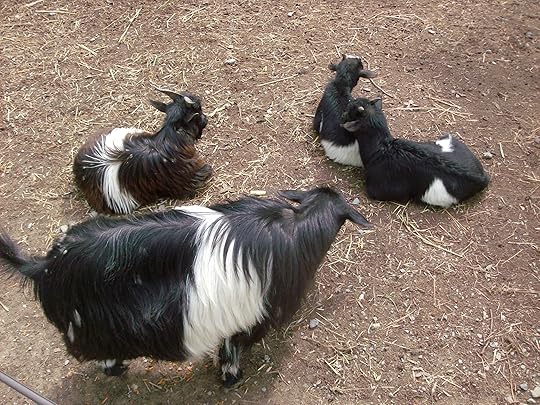
Tennessee fainting goats. When frightened or threatened, they fall to the ground.
After the bookstore event we drove to a Barnes and Noble to see if our books were in stock, and then home to Molly's place in Apex. For dinner we had fantastic panini sandwiches made with pimento cheese and videlia onions.
I've enjoyed learning about North Carolina. That the state economy used to be based on tobacco, that the singer James Taylor's family comes from Chapel Hill where his father was dean of the school of medicine at UNC, that cotton is making a come back in the Southern states and that college basketball is big in these parts.








Elizabeth J. Duncan's Blog
- Elizabeth J. Duncan's profile
- 399 followers





